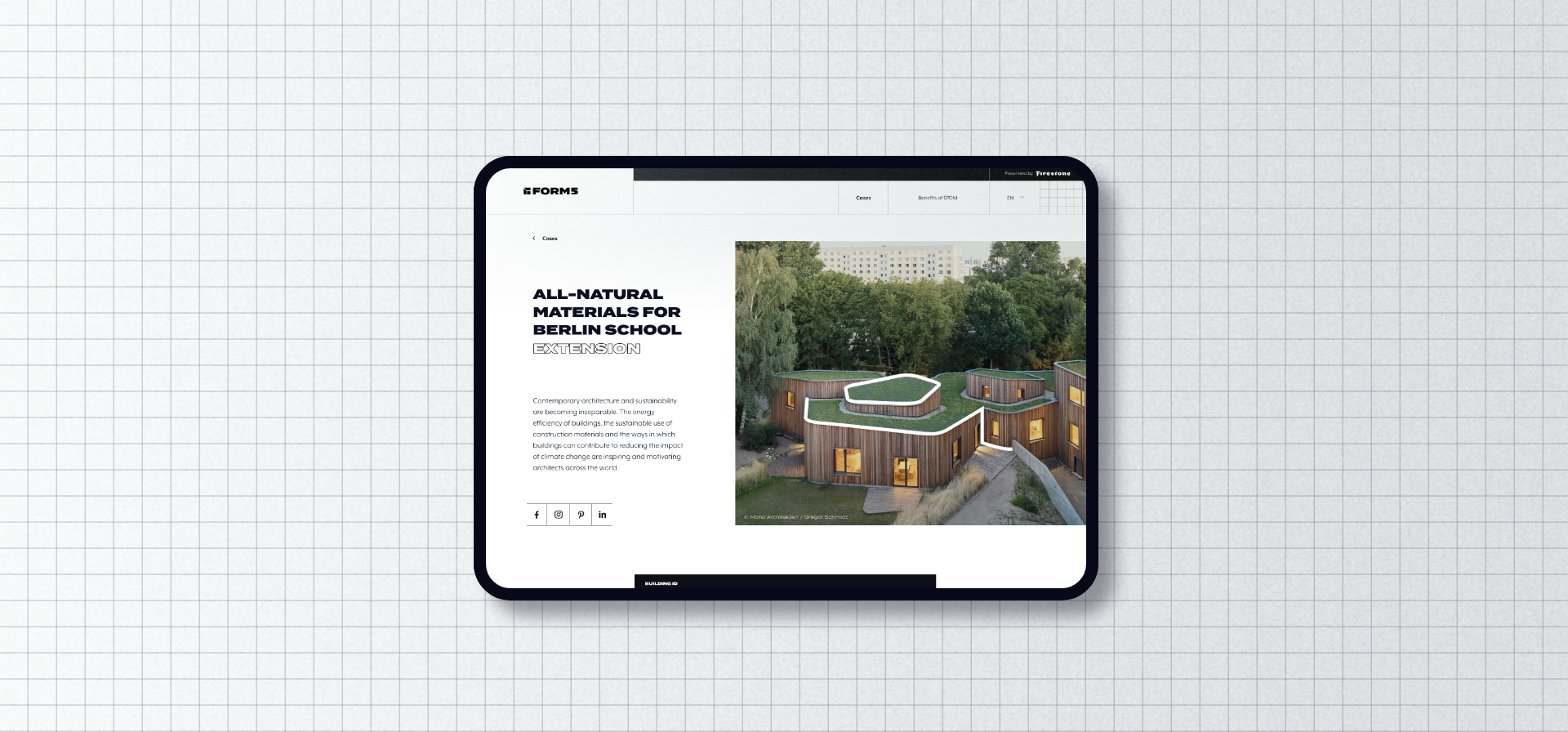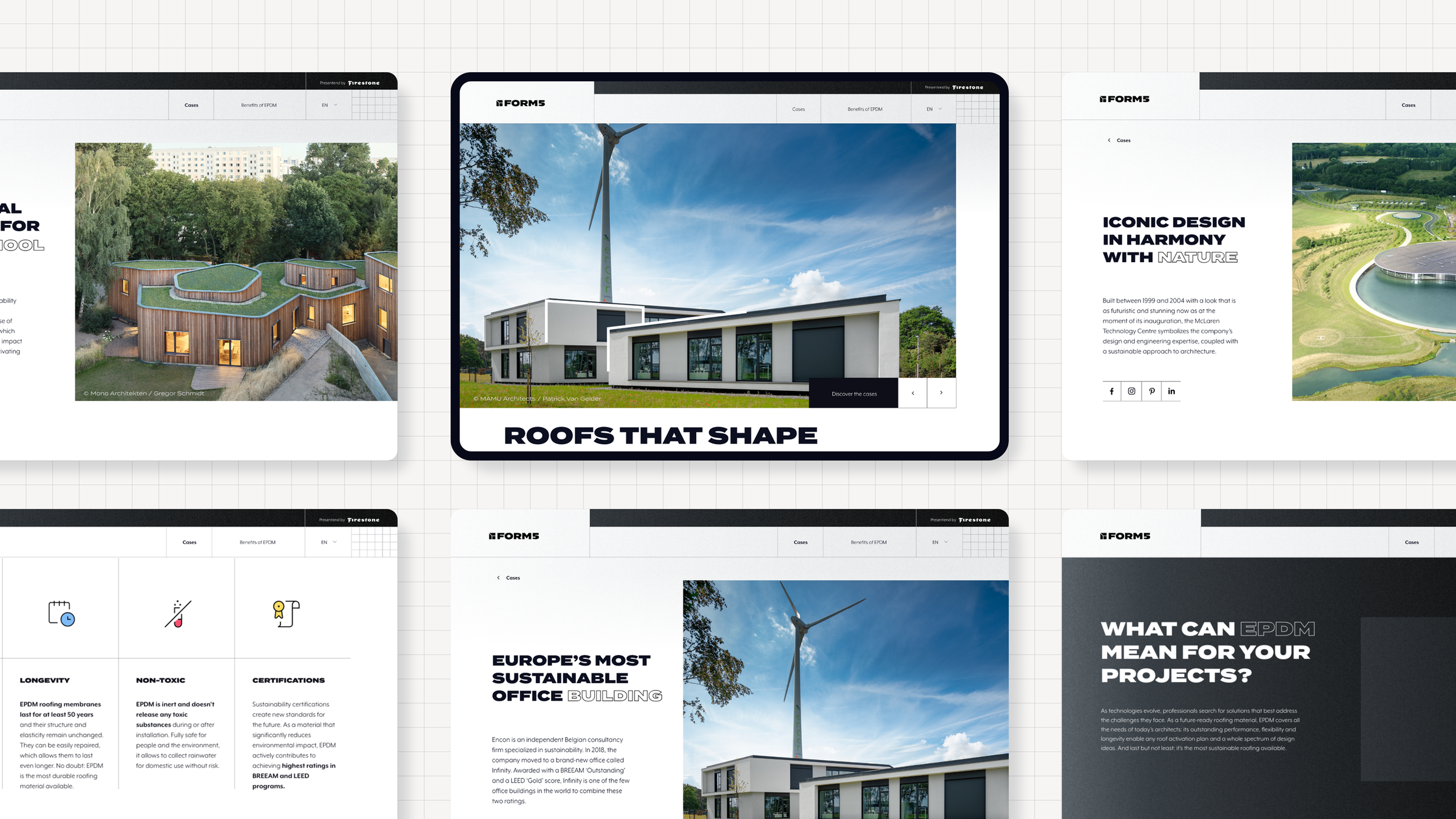Firestone
Inspiring architects with roofs that shape the future
Firestone is a global leader in rubber polymer technology and innovation. Known mostly for the production of tyres, Firestone is also a manufacturer of rubber-based roofing systems. EPDM roofing membrane is one of their flag products: sustainable and exceptionally flexible and durable, it defines a whole new standard in architecture. With the help of Digitalum, Adobe experts in online customer experiences and ecommerce solutions, we developed an inspirational platform with editorial content dedicated to architects, supported by an elaborate marketing plan, to build top-of-mind awareness and educate on the benefits of EPDM.

Architects and construction engineers typically work with materials they know well. These choices and habits are often country- or region-specific. In order to find the optimal way to raise their awareness around the benefits and possibilities of EPDM, we started with a thorough research. The goal? Getting to know the journeys of architects in different countries, pinpointing their needs and challenges, discovering differences between countries that include laws and procedures as well as awareness and sentiments on using EPDM. Last but not least, we conducted a keyword research.
“Thanks to an extensive keyword research, we were able to map out specific questions people ask when designing a building and selecting the roofing material. That’s how we noticed that not all the queries concern specific products. Very often, people search for solutions to their specific problems or simply search for a visual inspiration.”
Lisa Nevejans - Online Marketeer
We turned this valuable input into a strategic roadmap and a creative brief, which allowed us to develop an optimal solution. Introducing: Form5, an inspirational content platform with all you need to know about EPDM.

Form5 is a website with in-depth, editorial content created for architects and construction experts who are looking for relevant inspiration and information. When developing the concept, we took an approach that puts customers first, rather than the product. Traditionally, a manufacturer exhibits the product and talks about its benefits in an inside-out way, requiring the audience to look for more information, inspiration or examples of application themselves. Especially in the early stages of the journey, such flow proves to be counter productive.
Built with a customer-centric mindset, Form5 first focuses on challenges and needs of its audience, only then placing the product as a relevant solution.
We linked key challenges of modern architecture (sustainability, design freedom and active rooftops), with core benefits of EPDM. In order to showcase how the benefits work in practice, we created a bank of articles and cases, defined based on research and strategic input.
Sharp design and smooth UX were an important part of creating Form5. A sleek visual system works well on the platform as well as social media.
Since the website is focusing on product awareness and inspiration, Firestone branding is reduced to minimum. The link with the brand is clearly marked on the page, as well as in the UX design: for all technical and product-related information, the users are redirected to the Firestone page. The platform itself has no dead ends: thanks to a smart linking system, users who discover the universe of Form5 enter a loop that guides them from cases to benefits and the other way round, always showing relevant content and follow-up examples.
In order to generate awareness around EPDM and Form5 itself, we produced a set of 100+ digital assets that cover different steps in the customer journey, including the visual search for inspiration. For example, we created “Building IDs”, digital cards that combine beautiful photography with information about the project. Something architects usually need to look up themselves in many steps when trying to find out more about the projects they like.
The assets will be used in a smart marketing approach that reaches architects on Facebook, LinkedIn, Instagram and Pinterest. Always keeping the research findings in mind, we thought out a well-considered targeting and the moments when we could reach out to architects by tapping into their inspiration search habits. That’s why we combined more ‘classic’ platforms such as Facebook and LinkedIn together with very visual platforms like Pinterest and Instagram, that were often mentioned during the research phase.
As the platform is getting discovered by architects and building-enthusiasts, we can't wait to see the popularity of RubberGard EPDM go through the roof.